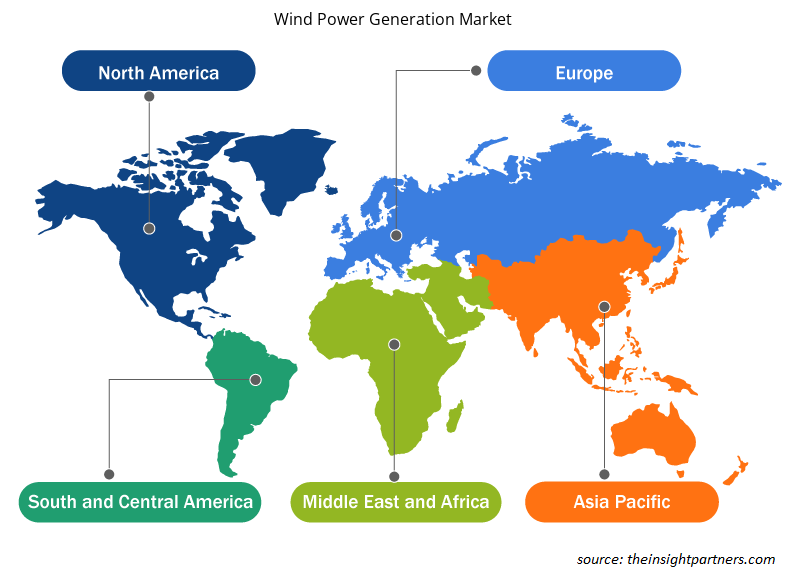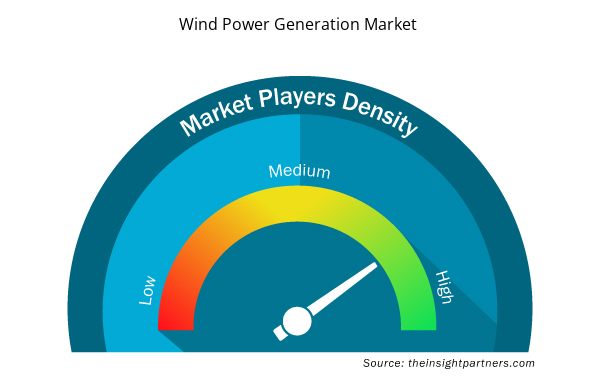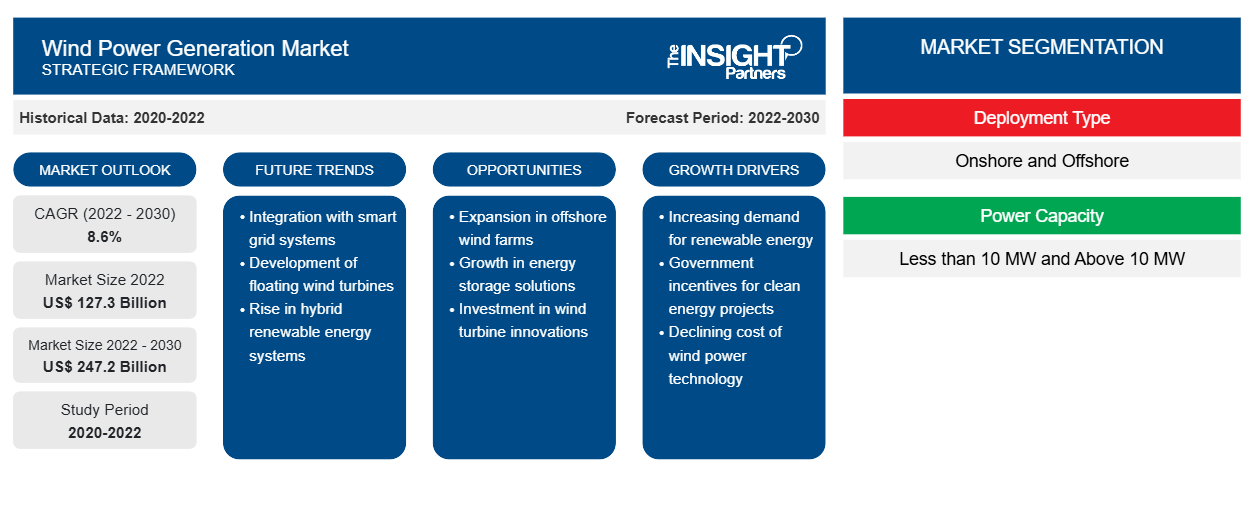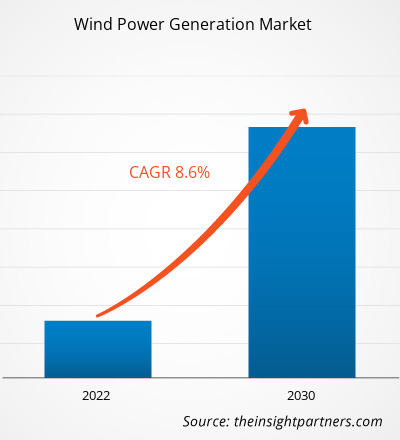[研究报告] 2022 年风力发电市场规模价值 1273 亿美元,预计到 2030 年将达到 2472 亿美元;预计 2022-2030 年期间的复合年增长率为 8.6%。
分析师观点:
风力发电市场报告的范围涵盖北美、欧洲、亚太地区(APAC)、中东和非洲(MEA)和南美(SAM)。
预测期内,风力发电市场预计将以 11.4% 的复合年增长率增长。这归因于亚太、北美和欧洲等地区陆上和海上风力发电量的增加。亚太地区全球风力发电市场的增长主要归因于可再生能源行业投资的增加、工业化和城镇化的迅猛增长、风能发电能力、新的电气化项目和电网强化计划。一项新研究表明,亚太地区风能行业将迅速扩张。由于国内对海上风电的高需求使中国大陆到 2030 年成为全球最大的市场,预计本十年风能将占该地区发电能力的近四分之一。
市场概况:
风能可将流动空气的动能转化为发电能,从而用于发电。在现代风力涡轮机中,风会转动转子叶片,从而将动能进一步转化为旋转能。旋转能通过轴传输到风力发电机,从而产生电能。根据 IRENA 的数据,从 2000 年到 2022 年,全球风力发电装机容量增长了 95% 以上。全球陆上风电装机容量从 2010 年的 178 吉瓦增长到 2020 年的 699 吉瓦,而海上风电的增幅更大,尽管起点较低,但从 2010 年的 3.1 吉瓦增长到 2020 年的 34.4 吉瓦。
即将启动的风电项目预计将于 2024 年和 2025 年开始运营,这将进一步加速风力发电能力的提升。根据瑞典能源署 2022 年 3 月发布的报告,瑞典的风力发电量预计将从 2021 年的 27.4 TWh 增加到 2024 年的 46.9 TWh。根据已发表的分析,预计到 2024 年,瑞典的风力发电量将比 2021 年增加 70% 以上。这一举措旨在减少该国对俄罗斯供应的化石燃料和石油和天然气的依赖。此外,葡萄牙主要公用事业公司 EDP 与法国公司 Engie 的合资企业 Ocean Winds 宣布,计划到 2025 年投资 31.5 亿美元开发海上风电项目。合资企业的平等合作伙伴的目标是生产约 7GW 的新产能。因此,这些即将到来的投资计划预计将使风力发电市场受益。
根据美国能源部的数据,美国海上风电市场预计将在未来十年实现大规模增长。海上拍卖价格下降、项目水深增加、涡轮机容量上升以及能源平准化成本下降是未来风力发电市场的突出趋势,预计这些趋势将进一步促进 2022 年至 2030 年的市场增长。COVID-19 的影响反映在美国、印度和台湾等市场的项目调试放缓。尽管 COVID-19 再次爆发,但 2021 年全球陆上风电拍卖活动总体上仍保持正常。中国在 2021 年共分配了 50.6 吉瓦的陆上风电容量,发挥了主导作用,其次是西班牙、印度、南非和德国。当前的全球形势表明,能源政策、新政策举措和大量投资前景不断涌现,这增加了风电设施实现净零排放和能源安全目标的轨迹。
定制此报告以满足您的需求
您可以免费定制任何报告,包括本报告的部分内容、国家级分析、Excel 数据包,以及为初创企业和大学提供优惠和折扣
- 获取此报告的关键市场趋势。这个免费样品将包括数据分析,从市场趋势到估计和预测。
市场驱动因素:
政府推动风电场建设的举措
各国政府在政策和投资方面对增加风能项目安装的支持预计将在未来几年推动风力发电市场的增长。印度政府通过提供各种财政和金融激励措施(例如加速折旧福利和对风力发电机某些部件的优惠关税豁免)通过私营部门投资推动该国的风电项目。2022年 1 月,中国人民银行 (PBOC) 开始提供低成本贷款来资助脱碳活动。此外,北京目前的政策举措侧重于向低碳项目开发商提供税收减免和低息贷款、电力市场改革和电网改善。在加拿大,海上可再生能源法规 (ORER) 计划预计将通过为加拿大近海地区的海上可再生能源 (ORE) 项目和电力线制定现代安全和环境保护法规来支持海上可再生能源项目和海上电力线的实施。
节段分析:
全球风力发电市场按部署类型分析分为陆上和海上。陆上部署部分占 2022 年风力发电市场总量的 80.94%。预计在预测期内它将保持主导地位。预计从 2022 年到 2030 年,海上部分在全球市场的增长率将达到 10.5%。这是由于北美和欧洲等地区对海上风电设施的投资增加。风力发电市场在采用海上风电技术方面的预测前景主要归因于技术进步、相关优势以及各种服务提供商提供的交钥匙解决方案的增加。对实现清洁能源目标的日益重视推动了对浮动海上风电的需求,为未来几年风力发电市场的增长提供了潜在机会。
区域分析:
根据 Insight Partners 的估计,2022 年,亚太地区的市场份额最高,为 39.8%,预计在分析期间将以 10.6% 的复合年增长率增长,这要归功于未来几年计划和正在进行的风电项目增加。亚太各国正致力于通过增加风力发电来采取关键战略,以实现碳减排目标和保障人民的能源安全。为了实现 2050 年的碳减排目标,该地区许多国家正在朝着无碳能源生产和利用的方向发展。印度是亚太地区风力发电市场第二大国家,2022 年总装机容量超过 1.5 吉瓦。该国对清洁发电的需求增加预计将推动风力发电市场的增长。欧洲和北美是关键地区,分别占 2022 年风力发电市场总份额的 28.4% 和 23.9%。
随着亚太地区可再生能源的快速增长,太阳能和风电将在整合不稳定可再生能源和确保整个电力系统的可靠性方面发挥越来越重要的作用。在许多国家,能源储存市场仍处于新兴阶段,但发展潜力巨大。全球风电装机容量预计将继续增长,以满足不断增长的电力需求和电力出口机会,并在全球范围内最大限度地发挥成本效益高、灵活性强的低碳能源的优势。
关键球员分析:
西门子歌美飒可再生能源公司、通用电气、三菱重工、维斯塔斯风力系统、可再生能源系统美洲公司、EDP 可再生能源公司、Orsted A/S、NextEra Energy, Inc.、EDF SA 和苏司兰能源有限公司是全球风力发电市场报告中介绍的关键参与者。
风力发电市场区域洞察
Insight Partners 的分析师已详细解释了预测期内影响风力发电市场的区域趋势和因素。本节还讨论了北美、欧洲、亚太地区、中东和非洲以及南美和中美洲的风力发电市场细分和地理位置。

- 获取风力发电市场的区域具体数据
风力发电市场报告范围
| 报告属性 | 细节 |
|---|---|
| 2022 年市场规模 | 1273亿美元 |
| 2030 年的市场规模 | 2472亿美元 |
| 全球复合年增长率(2022 - 2030 年) | 8.6% |
| 史料 | 2020-2022 |
| 预测期 | 2022-2030 |
| 涵盖的领域 | 按部署类型
|
| 覆盖地区和国家 | 北美
|
| 市场领导者和主要公司简介 |
|
风力发电市场参与者密度:了解其对业务动态的影响
风力发电市场正在快速增长,这得益于终端用户需求的不断增长,而这些需求又源于消费者偏好的不断变化、技术进步以及对产品优势的认识不断提高等因素。随着需求的增加,企业正在扩大其产品范围,进行创新以满足消费者的需求,并利用新兴趋势,从而进一步推动市场增长。
市场参与者密度是指在特定市场或行业内运营的企业或公司的分布情况。它表明在给定市场空间中,相对于其规模或总市场价值,有多少竞争对手(市场参与者)存在。
在风力发电市场运营的主要公司有:
- 西门子歌美飒可再生能源公司
- 通用电气
- 三菱重工
- 维斯塔斯风力系统
- 美洲可再生能源系统
免责声明:上面列出的公司没有按照任何特定顺序排列。

- 了解风力发电市场顶级关键参与者概况
最新动态:
全球风力发电市场中的公司普遍采用合作伙伴关系、协作、合并和收购等无机和有机战略。以下列出了主要市场参与者的一些最新发展:
年 | 消息 | 国家 |
2024 | 美国能源部与各州和研究机构合作,旨在推动该地区海上风电的发展。 | 北美 |
2022 | 维斯塔斯与 PEC Energia 合作在巴西建设一座 86 兆瓦风力发电场。凭借此项目,维斯塔斯自 2018 年以来在巴西安装 4 兆瓦平台风力涡轮机的订单量突破了 7 吉瓦的里程碑。 | 南美洲 |
2022 | 西门子歌美飒与 Azure Power 建立了新的合作伙伴关系,安装 96 台涡轮机,重点推动印度风电产业的发展。预计这将在未来几年增加印度的风力发电量。 | 亚太地区 |
- 历史分析(2 年)、基准年、预测(7 年)及复合年增长率
- PEST 和 SWOT 分析
- 市场规模价值/数量 - 全球、区域、国家
- 行业和竞争格局
- Excel 数据集


- Adaptive Traffic Control System Market
- Small Molecule Drug Discovery Market
- Frozen Potato Market
- Medical and Research Grade Collagen Market
- Aesthetic Medical Devices Market
- Nitrogenous Fertilizer Market
- Vertical Farming Crops Market
- Analog-to-Digital Converter Market
- Integrated Platform Management System Market
- Adaptive Traffic Control System Market

Report Coverage
Revenue forecast, Company Analysis, Industry landscape, Growth factors, and Trends

Segment Covered
This text is related
to segments covered.

Regional Scope
North America, Europe, Asia Pacific, Middle East & Africa, South & Central America

Country Scope
This text is related
to country scope.
常见问题
Ongoing research and innovation on advanced offshore wind power technologies in potential countries such as Brazil, U.S., India, Japan, and China where the adoption of the above-mentioned technology is maturing at a significant rate is expected to be the key opportunity in the market.
Siemens Gamesa Renewable Energy SA, General Electric, Mitsubishi Heavy Industries, Vestas Wind Systems, Renewable Energy Systems Americas, EDP Renewables, Orsted A/S, NextEra Energy, Inc., EDF S.A., and Suzlon Energy Limited are the key market players operating in the global wind power generation market.
Key role of wind power in future energy transition is anticipated to stimulate the wind power generation market growth in the coming years.
Regions such as Europe, North America and Asia-Pacific will boost the growth of the wind power generation market during the forecast period. This growth is owing to the rise in investment on construction of wind power plant facilities in the regions.
Rise in demand for power generation from less carbon emitting sources, rise in establishment of wind power plants, rise in awareness towards renewable energy resources are contributing to the growth of the wind power generation market.
Trends and growth analysis reports related to Energy and Power : READ MORE..
The List of Companies - Wind Power Generation Market
- Siemens Gamesa Renewable Energy SA
- General Electric
- Mitsubishi Heavy Industries
- Vestas Wind Systems
- Renewable Energy Systems Americas
- EDP Renewables
- Orsted A/S
- NextEra Energy, Inc.
- EDF S.A.
- Suzlon Energy Limited
The Insight Partners performs research in 4 major stages: Data Collection & Secondary Research, Primary Research, Data Analysis and Data Triangulation & Final Review.
- Data Collection and Secondary Research:
As a market research and consulting firm operating from a decade, we have published and advised several client across the globe. First step for any study will start with an assessment of currently available data and insights from existing reports. Further, historical and current market information is collected from Investor Presentations, Annual Reports, SEC Filings, etc., and other information related to company’s performance and market positioning are gathered from Paid Databases (Factiva, Hoovers, and Reuters) and various other publications available in public domain.
Several associations trade associates, technical forums, institutes, societies and organization are accessed to gain technical as well as market related insights through their publications such as research papers, blogs and press releases related to the studies are referred to get cues about the market. Further, white papers, journals, magazines, and other news articles published in last 3 years are scrutinized and analyzed to understand the current market trends.
- Primary Research:
The primarily interview analysis comprise of data obtained from industry participants interview and answers to survey questions gathered by in-house primary team.
For primary research, interviews are conducted with industry experts/CEOs/Marketing Managers/VPs/Subject Matter Experts from both demand and supply side to get a 360-degree view of the market. The primary team conducts several interviews based on the complexity of the markets to understand the various market trends and dynamics which makes research more credible and precise.
A typical research interview fulfils the following functions:
- Provides first-hand information on the market size, market trends, growth trends, competitive landscape, and outlook
- Validates and strengthens in-house secondary research findings
- Develops the analysis team’s expertise and market understanding
Primary research involves email interactions and telephone interviews for each market, category, segment, and sub-segment across geographies. The participants who typically take part in such a process include, but are not limited to:
- Industry participants: VPs, business development managers, market intelligence managers and national sales managers
- Outside experts: Valuation experts, research analysts and key opinion leaders specializing in the electronics and semiconductor industry.
Below is the breakup of our primary respondents by company, designation, and region:

Once we receive the confirmation from primary research sources or primary respondents, we finalize the base year market estimation and forecast the data as per the macroeconomic and microeconomic factors assessed during data collection.
- Data Analysis:
Once data is validated through both secondary as well as primary respondents, we finalize the market estimations by hypothesis formulation and factor analysis at regional and country level.
- Macro-Economic Factor Analysis:
We analyse macroeconomic indicators such the gross domestic product (GDP), increase in the demand for goods and services across industries, technological advancement, regional economic growth, governmental policies, the influence of COVID-19, PEST analysis, and other aspects. This analysis aids in setting benchmarks for various nations/regions and approximating market splits. Additionally, the general trend of the aforementioned components aid in determining the market's development possibilities.
- Country Level Data:
Various factors that are especially aligned to the country are taken into account to determine the market size for a certain area and country, including the presence of vendors, such as headquarters and offices, the country's GDP, demand patterns, and industry growth. To comprehend the market dynamics for the nation, a number of growth variables, inhibitors, application areas, and current market trends are researched. The aforementioned elements aid in determining the country's overall market's growth potential.
- Company Profile:
The “Table of Contents” is formulated by listing and analyzing more than 25 - 30 companies operating in the market ecosystem across geographies. However, we profile only 10 companies as a standard practice in our syndicate reports. These 10 companies comprise leading, emerging, and regional players. Nonetheless, our analysis is not restricted to the 10 listed companies, we also analyze other companies present in the market to develop a holistic view and understand the prevailing trends. The “Company Profiles” section in the report covers key facts, business description, products & services, financial information, SWOT analysis, and key developments. The financial information presented is extracted from the annual reports and official documents of the publicly listed companies. Upon collecting the information for the sections of respective companies, we verify them via various primary sources and then compile the data in respective company profiles. The company level information helps us in deriving the base number as well as in forecasting the market size.
- Developing Base Number:
Aggregation of sales statistics (2020-2022) and macro-economic factor, and other secondary and primary research insights are utilized to arrive at base number and related market shares for 2022. The data gaps are identified in this step and relevant market data is analyzed, collected from paid primary interviews or databases. On finalizing the base year market size, forecasts are developed on the basis of macro-economic, industry and market growth factors and company level analysis.
- Data Triangulation and Final Review:
The market findings and base year market size calculations are validated from supply as well as demand side. Demand side validations are based on macro-economic factor analysis and benchmarks for respective regions and countries. In case of supply side validations, revenues of major companies are estimated (in case not available) based on industry benchmark, approximate number of employees, product portfolio, and primary interviews revenues are gathered. Further revenue from target product/service segment is assessed to avoid overshooting of market statistics. In case of heavy deviations between supply and demand side values, all thes steps are repeated to achieve synchronization.
We follow an iterative model, wherein we share our research findings with Subject Matter Experts (SME’s) and Key Opinion Leaders (KOLs) until consensus view of the market is not formulated – this model negates any drastic deviation in the opinions of experts. Only validated and universally acceptable research findings are quoted in our reports.
We have important check points that we use to validate our research findings – which we call – data triangulation, where we validate the information, we generate from secondary sources with primary interviews and then we re-validate with our internal data bases and Subject matter experts. This comprehensive model enables us to deliver high quality, reliable data in shortest possible time.


 获取此报告的免费样本
获取此报告的免费样本